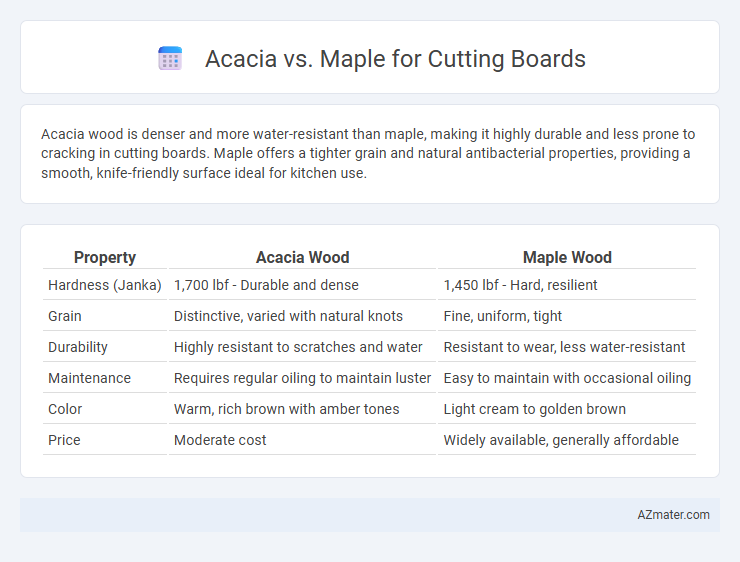Acacia wood is denser and more water-resistant than maple, making it highly durable and less prone to cracking in cutting boards. Maple offers a tighter grain and natural antibacterial properties, providing a smooth, knife-friendly surface ideal for kitchen use.
Table of Comparison
| Property | Acacia Wood | Maple Wood |
|---|---|---|
| Hardness (Janka) | 1,700 lbf - Durable and dense | 1,450 lbf - Hard, resilient |
| Grain | Distinctive, varied with natural knots | Fine, uniform, tight |
| Durability | Highly resistant to scratches and water | Resistant to wear, less water-resistant |
| Maintenance | Requires regular oiling to maintain luster | Easy to maintain with occasional oiling |
| Color | Warm, rich brown with amber tones | Light cream to golden brown |
| Price | Moderate cost | Widely available, generally affordable |
Introduction: Acacia vs Maple Cutting Boards
Acacia cutting boards are valued for their durability and natural water resistance, making them less prone to cracking and warping. Maple cutting boards offer a dense, fine grain that resists knife marks and provides a smooth, sanitary surface. Both woods are popular choices, but Acacia's rich color and maple's light, uniform appearance cater to different aesthetic and functional preferences.
Wood Characteristics: Acacia and Maple Compared
Acacia wood features a rich, dark grain that offers natural resistance to bacteria and water, making it highly durable and ideal for cutting boards. Maple wood is lighter in color with a tighter grain, known for being hard, smooth, and less prone to knife marks, ensuring a clean and safe chopping surface. Both woods are hardwood varieties favored for their longevity and hygienic properties, but acacia tends to be more moisture-resistant while maple is easier to maintain.
Durability and Longevity
Acacia wood offers exceptional durability and natural resistance to water and bacteria, making it a top choice for cutting boards in busy kitchens. Maple is renowned for its hardness and fine grain, which provides excellent longevity and a smooth, scratch-resistant surface. Both woods are sustainable options, but Acacia's denser composition typically results in greater wear resistance over time compared to Maple.
Knife Friendliness and Surface Performance
Acacia offers excellent knife friendliness due to its moderate hardness, preventing dulling while maintaining durability, whereas maple is renowned for its fine, closed grain that provides a smooth, non-porous surface ideal for food preparation. The surface performance of acacia is enhanced by natural oils that resist stains and moisture, reducing the risk of warping, while maple's dense structure absorbs less moisture, ensuring a sanitary cutting environment. Both woods balance durability and knife care, but maple's tighter grain generally results in a gentler impact on blades over extended use.
Maintenance and Cleaning Requirements
Acacia cutting boards require regular oiling with mineral oil to maintain their natural water resistance and prevent cracking, while maple boards are also durable but benefit from more frequent conditioning due to their slightly porous surface. Both types need to be cleaned promptly with warm, soapy water and thoroughly dried to avoid warping or bacteria growth. Acacia's natural antimicrobial properties provide an edge in hygiene, but consistent maintenance is crucial for both woods to preserve longevity and appearance.
Aesthetic Appeal: Grain, Color, and Finish
Acacia cutting boards feature rich, warm tones with contrasting dark grain patterns that provide a unique, rustic aesthetic ideal for farmhouse or natural-themed kitchens. Maple cutting boards showcase a lighter, more uniform color with fine, straight grain, offering a clean and classic look that complements contemporary or minimalist styles. Both woods have smooth finishes that enhance their natural beauty, but Acacia's varied grain and deeper hues often create a more striking visual impact.
Sustainability and Environmental Impact
Acacia wood for cutting boards is sustainably harvested from fast-growing trees with a lower carbon footprint, making it an eco-friendly choice compared to maple, which typically comes from slower-growing hardwood forests requiring longer regeneration periods. The dense, durable grain of acacia reduces the need for chemical treatments, enhancing its environmental advantages over maple that may require more maintenance and finishes. Choosing acacia supports responsible forestry practices and helps reduce deforestation pressures associated with traditional maple harvesting.
Cost and Value for Money
Acacia cutting boards typically offer a more affordable price point while providing strong durability and natural antimicrobial properties, making them a cost-effective choice. Maple boards tend to be pricier due to their dense hardwood quality and resistance to knife marks, delivering long-lasting performance and better value for frequent use. When comparing cost and value for money, Acacia suits budget-conscious buyers seeking solid utility, whereas Maple appeals to those prioritizing longevity and premium quality.
Popular Uses in Kitchen Settings
Acacia cutting boards are prized for their natural antimicrobial properties and durability, making them ideal for heavy-duty chopping and slicing tasks in busy kitchens. Maple cutting boards are favored for their tight grain and hardness, providing a smooth, knife-friendly surface perfect for precision cutting and easy cleaning. Both woods resist warping and moisture damage, with acacia offering a more striking aesthetic, while maple is traditionally recognized for its longevity and hygiene in kitchen use.
Conclusion: Which is the Better Choice?
Acacia cutting boards offer superior durability and natural antibacterial properties, making them highly resistant to moisture and heavy use compared to maple. Maple boards are prized for their fine grain and smooth texture, which is gentle on knives but can be more prone to scratches and water damage over time. For long-lasting performance and enhanced resistance to wear, acacia is generally the better choice for cutting boards.

Infographic: Acacia vs Maple for Cutting Board
 azmater.com
azmater.com